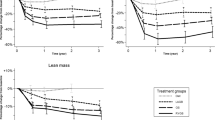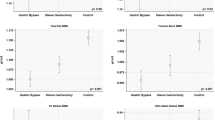Abstract
OBJECTIVE: To investigate whether osteoporosis occurs after surgical treatment for obesity.
DESIGN: A cross-sectional study of five groups of subjects who had undergone surgical treatment for obesity: five pre-menopausal women; 13 post-menopausal women; seven post-menopausal women taking oestrogen replacement (HRT); five men; and six women who had undergone surgical reversal (mean time 7 y).
SUBJECTS: Thirty-six Caucasian subjects who had undergone jejunoileal or pancreaticobiliary bypass surgery at St George’s Hospital between 1971 and 1992. Their mean age was 50.8 y (range 32–69 y) and the median time since the operation was 14.8 y (range 4–23 y).
MEASUREMENTS: A clinical questionnaire was used to exclude possible factors, which might influence bone mineral density. A single blood sample was collected for measurement of calcium, phosphate, alkaline phosphatase, albumin, magnesium, zinc, creatinine, thyroxine, 25-hydroxy-vitamin D, sex steroids, gonadotrophins and IGF-1 and 24 h urine calcium excretion was measured. Bone mineral density (BMD) was measured in the lumbar (L2-L4) spine (LS) and femoral neck (FN) by dual energy X-ray absorptiometry (DEXA).
RESULTS: There was no difference in serum calcium, alkaline phosphatase, IGF-1, 25-hydroxy-vitamin D (25-OH vitamin D), magnesium or zinc concentrations between the five groups. The LS-BMD T score was lower (P<0.05) in male subjects (−2.08±1.04 mean 1.0±s.d) and post-menopausal women not taking HRT (−1.21±1.33) compared to the surgically reversed group (0.87±2.36). The male group was most severely affected, despite normal serum testosterone concentrations. Two of the five men studied, had a LS-BMD T score <−2.5 and two had a LS-BMD T score between −1.0 and −2.5. In contrast, six of the seven post-menopausal women on HRT had an LS BMD T score >−1.0. There was no difference in the FN-BMD between the five groups. The presence of low BMD was not related to age, duration of bypass, or degree of postoperative weight loss. Iliac crest bone biopsies in three subjects with low BMD, confirmed the presence of osteoporosis.
CONCLUSIONS: Reduced bone mineral density is a complication of jejunoileal bypass surgery.
This is a preview of subscription content, access via your institution
Access options
Subscribe to this journal
Receive 12 print issues and online access
$259.00 per year
only $21.58 per issue
Buy this article
- Purchase on Springer Link
- Instant access to full article PDF
Prices may be subject to local taxes which are calculated during checkout
Similar content being viewed by others
Author information
Authors and Affiliations
Rights and permissions
About this article
Cite this article
Bano, G., Rodin, D., Pazianas, M. et al. Reduced bone mineral density after surgical treatment for obesity. Int J Obes 23, 361–365 (1999). https://doi.org/10.1038/sj.ijo.0800827
Received:
Revised:
Accepted:
Published:
Issue Date:
DOI: https://doi.org/10.1038/sj.ijo.0800827
Keywords
This article is cited by
-
Bariatric Surgery and Effects on Calcium and Bone Metabolism
Clinical Reviews in Bone and Mineral Metabolism (2014)
-
Examining the Link Between Bariatric Surgery, Bone Loss, and Osteoporosis: a Review of Bone Density Studies
Obesity Surgery (2012)
-
Bone Mineral Density and Nutritional Profile in Morbidly Obese Women
Obesity Surgery (2010)
-
Evaluation of Bone Disease in Morbidly Obese Women After Gastric Bypass and Risk Factors Implicated in Bone Loss
Obesity Surgery (2009)
-
Effect of Roux-en Y Gastric Bypass on Bone Metabolism in Patients with Morbid Obesity: Mansoura Experiences
Obesity Surgery (2008)



